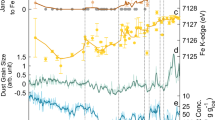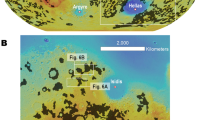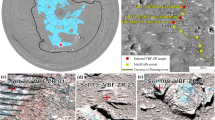Abstract
The sulphate-rich deposits at Meridiani Planum, Mars, discovered by the rover Opportunity, were proposed to be playa evaporites that had been reworked by eolian processes. Alternative hypotheses include volcanic or impact-driven formation of the sediments. Here we argue that the cation chemistry, scale, mineralogy and structure of the Meridiani sedimentary deposits are best explained by eolian or impact-driven reworking of the sublimation residue from a large-scale deposit consisting of dust and ice. We suggest that silicate material underwent significant acid weathering inside the ice deposit when thin films of water, formed through radiant heating, enabled the reaction between silicate material and sulphate-rich aerosols deposited from the atmosphere. The massive ice deposit could have formed during a period of high obliquity or polar wander, and subsequently sublimed away when obliquity changed or the pole moved to a new location. We propose acid weathering inside massive ice deposits as an explanation for the formation of many of the sulphate-rich layered deposits on Mars, which share many characteristics, including mineralogy, structure, erosional characteristics and size, with the sediments found at Meridiani Planum.
This is a preview of subscription content, access via your institution
Access options
Subscribe to this journal
Receive 12 print issues and online access
$259.00 per year
only $21.58 per issue
Buy this article
- Purchase on Springer Link
- Instant access to full article PDF
Prices may be subject to local taxes which are calculated during checkout




Similar content being viewed by others
References
Squyres, S. W. et al. Two years at Meridiani Planum: Results from the Opportunity Rover. Science 313, 1403–1407 (2006).
Arvidson, R. E. et al. Nature and origin of the hematite-bearing plains of Terra Meridiani based on analyses of orbital and Mars Exploration rover data sets. J. Geophys. Res. 111, E12S08 (2006).
Burns, R. G. Ferric sulfates on Mars. J. Geophys. Res. 92, E570–E574 (1987).
Andrews-Hanna, J. C., Phillips, R. J. & Zuber, M. T. Meridiani Planum and the global hydrology of Mars. Nature 446, 163–166 (2007).
Knauth, L. P., Burt, D. M. & Wohletz, K. H. Impact origin of sediments at the Opportunity landing site on Mars. Nature 438, 1123–1128 (2005).
McCollom, T. M. & Hynek, B. M. A volcanic environment for bedrock diagenesis at Meridiani Planum on Mars. Nature 438, 1129–1131 (2005).
Hynek, B. M. & Phillips, R. J. The stratigraphy of Meridiani Planum, Mars, and implications for the layered deposits’ origin. Earth Planet. Sci. Lett. 274, 214–220 (2008).
Zolotov, M. Y. & Mironenko, M. V. Timing of acid weathering on Mars: A kinetic-thermodynamic assessment. J. Geophys. Res. 112, E07006 (2007).
Catling, D. C. et al. Light-toned layered deposits in Juventae Chasma, Mars. Icarus 181, 26–51 (2006).
McAdam, A. C., Zolotov, M. Y., Sharp, T. G. & Leshin, L. A. Preferential low-pH dissolution of pyroxene in plagioclase-pyroxene mixtures: Implications for martian surface materials. Icarus 196, 90–96 (2008).
Tanaka, K. L. Dust and ice deposition in the Martian geologic record. Icarus 144, 254–266 (2000).
Wanke, H. & Dreibus, G. Chemistry and accretion history of Mars. Phil. Trans. R. Soc. Lond. A 349, 285–293 (1994).
Clifford, S. M. et al. The state and future of Mars polar science and exploration. Icarus 144, 210–242 (2000).
Paerl, H. W. & Priscu, J. C. Microbial phototrophic, heterotrophic, and diazotrophic activities associated with aggregates in the permanent ice cover of Lake Bonney, Antarctica. Microbiol. Ecol. 36, 221–230 (1998).
Banin, A., Han, F. X., Kan, I. & Cicelsky, A. Acidic volatiles and the Mars soil. J. Geophys. Res. 102, 13341–13356 (1997).
Grotzinger, J. P. et al. Stratigraphy and sedimentology of a dry to wet eolian depositional system, Burns formation, Meridiani Planum, Mars. Earth Planet. Sci. Lett. 240, 11–72 (2005).
Golden, D. C., Ming, D. W., Morris, R. V. & Graff, T. G. Hydrothermal synthesis of hematite spherules and jarosite: Implications for diagenesis and hematite spherule formation in sulfate outcrops at Meridiani Planum, Mars. Am. Mineral. 93, 1201–1214 (2008).
Jakosky, B. M. & Carr, M. H. Possible precipitation of ice at low latitudes of Mars during periods of high obliquity. Nature 315, 559–561 (1985).
Levrard, B., Forget, F., Montmessin, F. & Laskar, J. Recent ice-rich deposits formed at high latitudes on Mars by sublimation of unstable equatorial ice during low obliquity. Nature 431, 1072–1075 (2004).
Schultz, P. H. & Lutz, A. B. Polar wandering of Mars. Icarus 73, 91–141 (1988).
Boynton, W. V. et al. Distribution of hydrogen in the near surface of Mars: Evidence for subsurface ice deposits. Science 297, 81–85 (2002).
Feldman, W. C. et al. Global distribution of neutrons from Mars: Results from Mars Odyssey. Science 297, 75–78 (2002).
Hood, L. L., Young, C. N., Richmond, N. C. & Harrison, K. P. Modeling of major martian magnetic anomalies: Further evidence for polar reorientations during the Noachian. Icarus 177, 144–173 (2005).
Watters, T. R. et al. Radar sounding of the Medusae Fossae Formation Mars: Equatorial ice or dry, low-density deposits? Science 318, 1125–1128 (2007).
Griffes, J. L., Arvidson, R. E., Poulet, F. & Gendrin, A. Geologic and spectral mapping of etched terrain deposits in northern Meridiani Planum. J. Geophys. Res. 112, E08S09 (2007).
Christensen, P. R., Morris, R. V., Lane, M. D., Bandfield, J. L. & Malin, M. C. Global mapping of Martian hematite mineral deposits: Remnants of water-driven processes on early Mars. J. Geophys. Res. 106, 23873–23885 (2001).
Hynek, B. M., Arvidson, R. E. & Phillips, R. J. Geologic setting and origin of Terra Meridiani hematite deposit on Mars. J. Geophys. Res. 107, 5088 (2002).
Smith, D. E. et al. The global topography of Mars and implications for surface evolution. Science 284, 1495–1503 (1999).
Zuber, M. T. et al. Density of Mars’ south polar layered deposits. Science 317, 1718–1719 (2007).
Mellon, M. T., Jakosky, B. M. & Postawko, S. E. The persistence of equatorial ground ice on Mars. J. Geophys. Res. 102, 19357–19369 (1997).
Clark, B. C. et al. Chemistry and mineralogy of outcrops at Meridiani Planum. Earth Planet. Sci. Lett. 240, 73–94 (2005).
McCollom, T. M. & Hynek, B. M. Bedrock formation at Meridiani Planum—Reply. Nature 443, E2 (2006).
Bibring, J. P. et al. Global mineralogical and aqueous Mars history derived from OMEGA/Mars Express data. Science 312, 400–404 (2006).
Malin, M. C. & Edgett, K. S. Mars Global Surveyor Mars Orbiter Camera: Interplanetary cruise through primary mission. J. Geophys. Res. 106, 23429–23570 (2001).
Malin, M. C. & Edgett, K. S. Sedimentary rocks of early Mars. Science 290, 1927–1937 (2000).
Edgett, K. S. The sedimentary rocks of Sinus Meridiani: Five key observations from data acquired by the Mars Global Surveyor and Mars Odyssey orbiters. Mars 1, 5–58 (2005).
Bibring, J. P. et al. Coupled ferric oxides and sulfates on the Martian surface. Science 317, 1206–1210 (2007).
Glotch, T. D. & Rogers, A. D. Evidence for aqueous deposition of hematite- and sulfate-rich light-toned layered deposits in Aureum and Iani Chaos, Mars. J. Geophys. Res. 112, E06001 (2007).
Langevin, Y., Poulet, F., Bibring, J.-P. & Gondet, B. Sulfates in the north polar region of Mars detected by OMEGA/Mars Express. Science 307, 1584–1586 (2005).
Christensen, P. R. et al. Mars Global Surveyor Thermal Emission Spectrometer experiment: Investigation description and surface science results. J. Geophys. Res. 106, 23823–23871 (2001).
Morris, R. V. et al. Mossbauer mineralogy of rock, soil, and dust at Gusev crater, Mars: Spirit’s journey through weakly altered olivine basalt on the plains and pervasively altered basalt in the Columbia Hills. J. Geophys. Res. 111, E02S13 (2006).
Morris, R. V. et al. Mossbauer mineralogy of rock, soil, and dust at Meridiani Planum, Mars: Opportunity’s journey across sulfate-rich outcrop, basaltic sand and dust, and hematite lag deposits. J. Geophys. Res. 111, E12S15 (2006).
McSween, H. Y. & Keil, K. Mixing relationships in the Martian regolith and the composition of globally homogeneous dust. Geochim. Cosmochim. Acta 64, 2155–2166 (2000).
McLennan, S. M. et al. Provenance and diagenesis of the evaporite-bearing Burns formation, Meridiani Planum, Mars. Earth Planet. Sci. Lett. 240, 95–121 (2005).
Acknowledgements
The manuscript was greatly improved by discussions with M. Kraft, D. Rogers, T. Glotch, R. Fergason and A. Baldridge. We gratefully acknowledge pictures of Antarctic ice cores from Dr. Hans Paerl. The manuscript has also been improved by thorough comments from D. Burt, B. Hynek and V. Chevrier. We also benefited from global data sets hosted by Arizona State University at http://jmars.asu.edu/data/. This material is based on work supported by a grant from the National Aeronautics and Space Administration issued through the Mars Fundamental Research Program. P.B.N. also acknowledges support from NASA/Johnson Space Center, and J.M. acknowledges support from Centre National d’Etudes Spatiale (CNES).
Author information
Authors and Affiliations
Contributions
P.B.N. wrote the majority of the manuscript. J.M. helped develop many of the ideas and figures, and wrote some sections of the paper.
Corresponding author
Supplementary information
Supplementary Information
Supplementary Information (PDF 427 kb)
Rights and permissions
About this article
Cite this article
Niles, P., Michalski, J. Meridiani Planum sediments on Mars formed through weathering in massive ice deposits. Nature Geosci 2, 215–220 (2009). https://doi.org/10.1038/ngeo438
Received:
Accepted:
Published:
Issue Date:
DOI: https://doi.org/10.1038/ngeo438
This article is cited by
-
Water Ice and Possible Habitability in the Landing Area of Tianwen-1 Mission
Space Science Reviews (2024)
-
Sustained wet–dry cycling on early Mars
Nature (2023)
-
Exploring the evidence of Middle Amazonian aquifer sedimentary outburst residues in a Martian chaotic terrain
Scientific Reports (2023)
-
Jarosite formation in deep Antarctic ice provides a window into acidic, water-limited weathering on Mars
Nature Communications (2021)
-
Geologic Constraints on Early Mars Climate
Space Science Reviews (2019)



